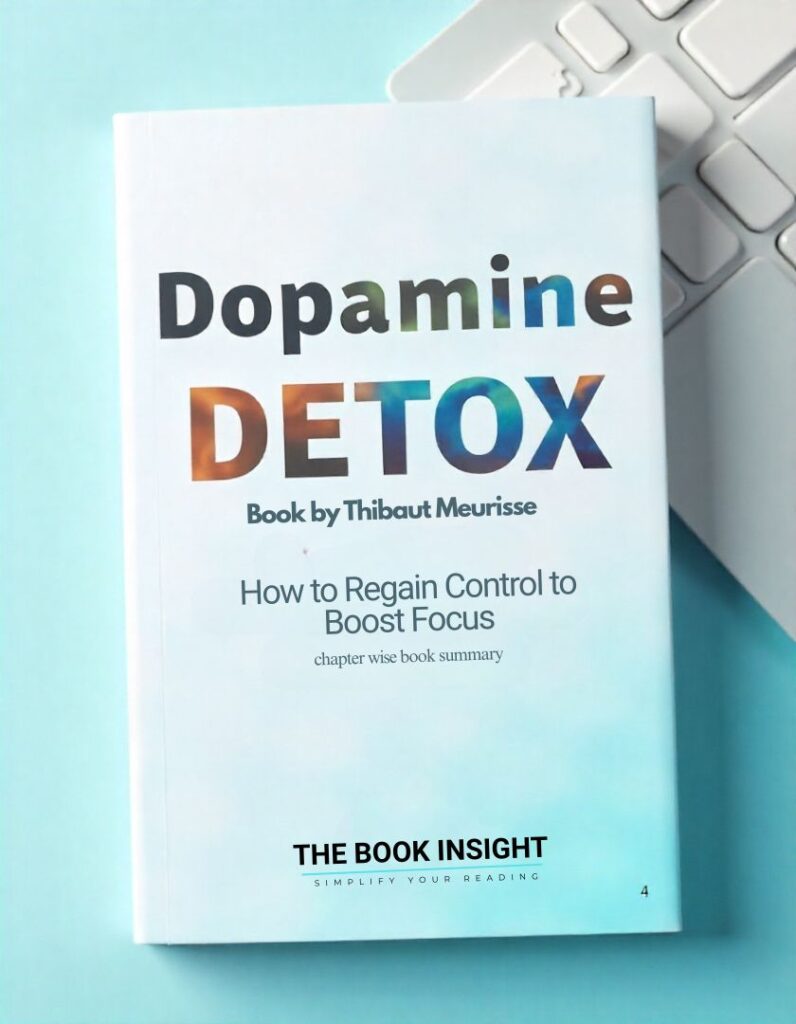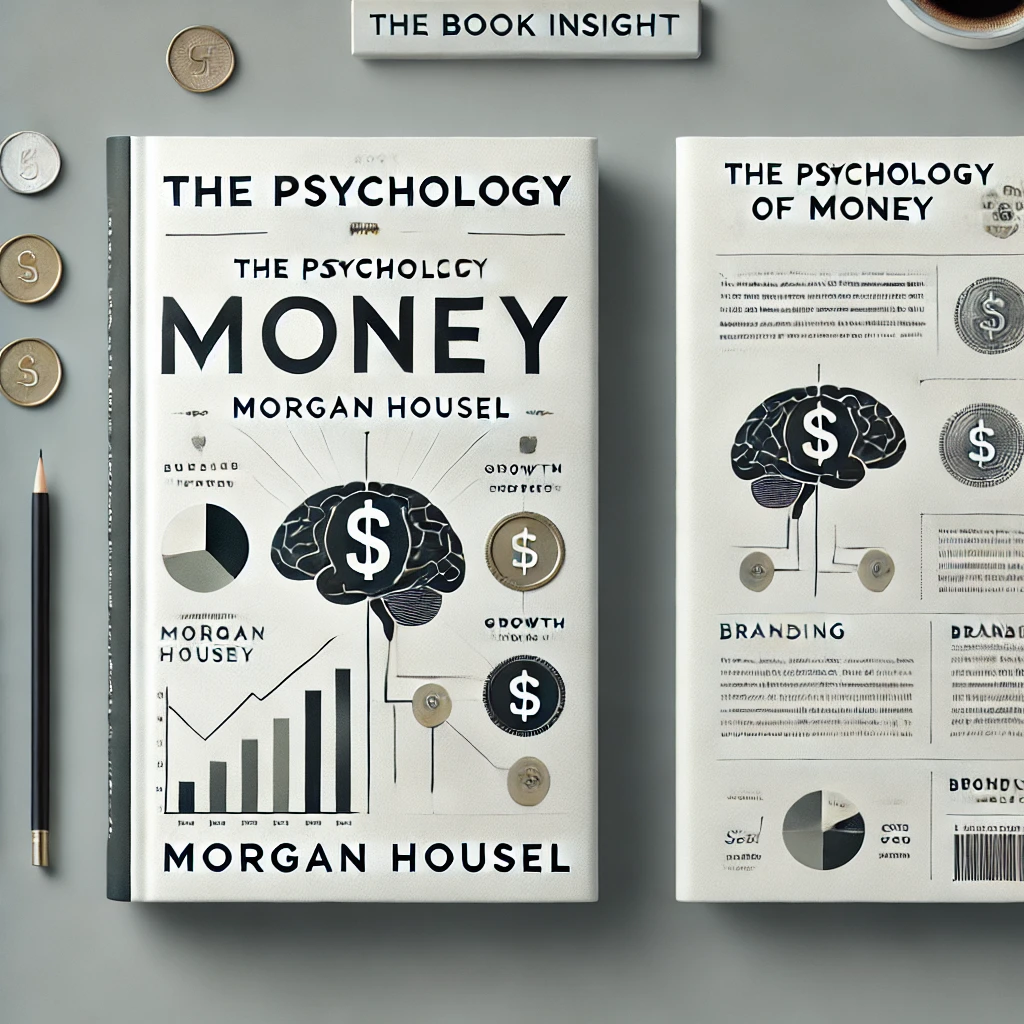Book Name: Dopamine Detox
Author Name: Thibaut Meurisse
Table of Contents
ToggleDopamine Detox Book Summary: Why Your Brain Craves Distractions (and How to Stop It)
In this Dopamine Detox book summary, we’ll explore how a tiny brain chemical can control your motivation, habits, and even your happiness. Dopamine — often called the “feel-good” neurotransmitter — drives our urge to seek pleasure, but in today’s world, it’s being hijacked like never before.
From endless scrolling on social media to binge-watching your favorite shows, modern life is designed to keep you chasing quick dopamine hits. The result? A restless mind, weakened focus, and a constant craving for stimulation. This book reveals why your brain works this way, how these patterns form, and most importantly, how you can reset your brain to take back control.
Before we dive into the key lessons, let’s understand what dopamine really is and why it plays such a powerful role in both our survival and our struggles.
Chapter 1: Understanding Dopamine – The Brain’s Reward Messenger
Dopamine is a neurotransmitter — a chemical messenger in the brain — that fuels our desire for rewards. It’s the reason we look forward to pleasures like delicious food, physical intimacy, or achieving a goal. Whenever we expect something enjoyable, dopamine is released, creating a sense of anticipation that pushes us to act.
This anticipation is what gives birth to desire. We take action, get the reward, and for a brief moment, feel satisfied. But soon after, there’s a sense of emptiness or incompleteness. Our brain craves that same feeling again, pushing us to repeat the activity.
This cycle is harmless in moderation, but in today’s world, many activities are engineered to trigger huge dopamine spikes — watching pornography, endlessly scrolling social media, binge-watching shows, or playing video games for hours. These high-intensity dopamine hits keep us hooked, training our brain to seek them again and again. Over time, they form habits, even addictions, that never truly satisfy us.
The problem? These artificially high dopamine triggers hijack our attention and make it harder to focus on tasks that require deep concentration — the very things we plan to do for our growth and success. Most of us have experienced this: we set aside time for something important, but a quick “dopamine fix” steals our attention, leaving us frustrated.
From an evolutionary perspective, dopamine plays an essential role in survival and reproduction. It motivates us to seek food, safety, companionship, and other life-sustaining rewards. But in the modern world, where instant gratification is available at the tap of a finger, dopamine’s natural role is often exploited — leading us down a path of distraction, dependency, and decreased self-control.
Dopamine Detox Key Takeaways from Chapter 1
- Dopamine is the brain’s reward chemical, driving us to seek pleasurable experiences.
- Anticipation of a reward often motivates us more than the reward itself.
- Modern technology and entertainment are designed to trigger high dopamine spikes, leading to repeated cravings.
- Overstimulation from constant dopamine hits can make focusing on important tasks more difficult.
- Evolutionarily, dopamine was meant to help us survive and reproduce, but in today’s world, it’s often hijacked for instant gratification.
Chapter 2: The Problem – How Dopamine Hijacks Your Focus
Dopamine is often called the molecule of more because once our brain experiences a pleasurable hit, it naturally wants more of it. The environment we live in today is filled with opportunities for constant dopamine stimulation — and each hit increases the likelihood of us repeating that activity. Whether it’s alcohol, gambling, sex, binge-watching TV, playing video games, or even overworking, the pattern is the same: once we start, it’s hard to stop.
The question we must ask ourselves is simple yet powerful:
Is there anything in my life that I truly cannot go without, even for a single day?
How Dopamine Has Been Hijacked
In the modern world, focus is the new wealth — and big companies know it. Social media platforms, apps, and entertainment giants spend billions to capture and hold your attention. The longer you stay on their platforms, the more they earn through ads.
One of the most effective tools they use is the notification. Every ping, like, or comment triggers a burst of dopamine, creating hope: Maybe it’s a message from someone important… maybe a new like… maybe a new follower. We click to find out — and before we know it, we’re trapped in an endless loop.
Algorithms study our habits and feed us exactly what will keep us scrolling — whether it’s a product we were already considering or a never-ending stream of videos. While sometimes useful, this constant targeting often leads to endless scrolling, stealing hours from our day and killing our ability to improve focus naturally.
Dopamine and the Trap of Constant Excitement
Scientific studies show that long-term thinking is a powerful predictor of success. Achieving big goals requires vision, patience, and strong mental discipline. Unfortunately, our brains are increasingly wired for short-term rewards.
We already know what’s good for us — yet we don’t do it:
- We know social media scrolling wastes time, yet we stay glued to it.
- We know junk food harms our health, yet we eat it anyway.
- We know reading and learning can change our life, yet Netflix and web series win our attention.
As our demand for excitement grows, our attention span shrinks. This fuels unhealthy mental models:
- Success should come quickly and easily.
- I don’t need to work hard to lose weight or earn money.
This mindset breeds impatience. When we see others succeed, envy and frustration take over. We start chasing shortcuts, hoping for instant results — and in the process, we break bad habits only to replace them with new ones. The foundation of patience, discipline, and consistency — the real core of success — begins to crumble.
Dopamine Detox Key Takeaways from Chapter 2
- Dopamine is the molecule of more — once triggered, it pushes us to seek more pleasure.
- Companies design apps and notifications to keep you hooked for profit.
- Constant dopamine hits hijack your brain, making it harder to focus on long-term goals.
- Awareness of bad habits isn’t enough — breaking free requires conscious effort to reset your brain.
- Success requires patience and consistency, not the quick-fix mentality fueled by overstimulation.
Chapter 3: The Benefits of a Dopamine Detox
What is Dopamine Detox?
A dopamine detox is a deliberate break from high-stimulation activities that constantly trigger the brain’s reward system. The goal is not to remove dopamine entirely — that’s impossible and unnecessary — but to reduce overstimulation so your brain can reset to a more balanced state.
When you limit constant pleasure triggers, you regain control over your attention and emotions. This creates mental space to focus on important, meaningful tasks without feeling restless or distracted. In short, it’s a way to reset your brain, overcome distractions, and improve focus naturally.
The Three Types of Dopamine Detox
1. 48-Hour Complete Dopamine Detox
This is the most intense form of detox. For two full days, you completely remove all sources of artificial dopamine spikes:
- Alcohol or narcotics
- Internet, movies, music
- Mobile phone and social media
- Video games
- Processed and junk food
During these 48 hours, you replace high-stimulation habits with grounding, low-dopamine activities that help you break bad habits:
- Journaling your thoughts
- Meditation or deep breathing exercises
- Reading physical books
- Taking long walks in nature
- Practicing gratitude or reflection
2. 24-Hour Dopamine Detox
A shorter but still effective version. You follow the same process as the 48-hour detox but limit it to just one day. This is ideal for beginners who want to try detoxing without feeling overwhelmed. Even a single day without digital distractions or instant gratification can boost mental clarity and focus.
3. Partial Dopamine Detox
This is a flexible approach where you remove only specific high-stimulation triggers while keeping essential daily tools. For example:
- Limiting social media to 10 minutes a day
- Turning off notifications
- Replacing junk food with healthy meals
- Cutting video games or binge-watching shows during workdays
A partial detox works well for building sustainable habits over time. It’s not about deprivation — it’s about regaining control.
Why a Dopamine Detox Works?
- Resets your brain to a natural baseline of motivation and pleasure.
- Breaks bad habits by removing the triggers that keep them alive.
- Improves focus naturally by reducing mental noise and distractions.
- Encourages long-term thinking and better decision-making.
- Helps you rediscover joy in simple, everyday activities.
Dopamine Detox Key Takeaways from Chapter 3
- Dopamine detox is about reducing stimulation, not eliminating dopamine.
- There are three main approaches: 48-hour complete, 24-hour short-term, and partial detox.
- Replacing high-stimulation habits with low-dopamine activities strengthens discipline.
- Even a partial detox can help you overcome distractions and build focus.
- The main benefit is regaining control over your mind, habits, and time.
Chapter 4: The 3-Step Approach to a Successful Dopamine Detox
A dopamine detox works best when it’s done intentionally and with a clear plan. Many people fail because they try to “just stop” bad habits without building a supportive structure around themselves. This chapter explains a simple three-step formula that helps you successfully reset your brain, break bad habits, and improve focus naturally.
Step 1: Identify Your Biggest Obstacles
Before starting your detox, you must clearly understand what’s standing in your way. This begins with honest self-reflection.
Practical Method:
- Take a piece of paper and draw two columns.
- In the left column, list the things you want to do (positive habits, productive tasks).
- In the right column, list the things you don’t want to do (distractions, high-dopamine habits).
Ask yourself questions like:
- Which activities do I keep going back to even though I know they waste my time?
- What triggers my urge to check my phone or snack mindlessly?
- What’s stopping me from focusing on my goals?
You can repeat these questions until you feel clarity or even talk to a trusted friend or mentor who can help you identify blind spots. This awareness is the foundation for your detox plan.
Step 2: Create Small Barriers (Cause a Little Disturbance)
Human beings are naturally wired for convenience. The easier it is to access something, the more likely we are to overuse it. That’s why adding friction between you and your distractions is a powerful tool in a dopamine detox.
Examples:
- Turn off social media notifications.
- Put your phone in another room or switch it to airplane mode.
- Uninstall apps that you frequently overuse.
- Keep junk food out of your house so you’re not tempted late at night.
The more bottlenecks you create, the easier it becomes to overcome distractions and give your brain the space it needs to reset.
Step 3: Control the First Hour of Your Day
What you do in the first hour after waking up sets the tone for the rest of your day. If you start your morning by grabbing your phone and scrolling, you instantly train your brain to seek quick dopamine hits. Instead, begin your day with at least three intentional activities that align with your detox goals:
- Yoga or stretching
- Gratitude journaling
- Reading a physical book
- Playing a musical instrument
- Meditation or deep breathing exercises
By controlling your mornings, you take control of your mindset — a principle also emphasized by Robin Sharma in The 5 AM Club.
Extra Tips for a Successful Dopamine Detox
Keep a Detox Journal
Write down what you feel during your detox:
- If you crave something, note it.
- If you feel restless, describe the sensation.
- If you experience clarity, capture the moment.
When we put our thoughts on paper, we externalize them. Stress and tension lose their grip because the mind no longer needs to hold onto them. Over time, your journal becomes a personal guide to understanding how your mind reacts to detoxing and what triggers need to be addressed.
Dopamine Detox Key Takeaways from Chapter 4
- A successful dopamine detox starts with identifying your biggest obstacles.
- Small barriers between you and distractions make it easier to break bad habits.
- Controlling your morning routine is one of the fastest ways to improve focus naturally.
- Journaling your experiences helps you understand your mind and stay committed.
- Consistency in small actions leads to lasting results.
Chapter 5: Mastering Productivity & Defeating Procrastination with Dopamine Detox
Why Planning Your Day Is Non-Negotiable
One of the quickest ways to break the cycle of procrastination is to start each day with a clear plan. When you know exactly what needs to be done, you free your mind from decision fatigue and give yourself a structured path to follow. Brian Tracy, in his book Eat That Frog, emphasizes the power of tackling your most important tasks first.
Instead of working reactively, write down 3 to 5 key tasks for the day—arranged by urgency and importance. Once you complete the first task, move on to the second, and keep going until your list is done. These tasks should always be aligned with your long-term life goals, not just busy work that fills your schedule.
The Three Core Pillars of Productivity
While there are countless productivity books and systems, they often come back to these three essential factors:
- Focus – The ability to fully concentrate on one task without falling into distractions from notifications, social media, or unnecessary multitasking.
- Consistency – Progress comes from showing up every day. Even small, regular efforts compound into massive results over weeks, months, and years.
- Effect – Not all tasks are created equal. Prioritize the ones that bring significant long-term results and have a lasting impact on your goals.
Developing Laser-Sharp Focus
A powerful way to train your brain is to work in focused bursts—ideally 45 minutes of deep work—before taking a short break. This technique aligns with the dopamine detox philosophy: removing high-stimulation distractions so your brain can channel its full energy into the task at hand.
5 Steps to Create a Distraction-Free Work Zone:
- Same Place, Same Time – Train your brain by working in the same environment and at the same time each day.
- Choose a Trigger – A simple ritual, like making tea or putting on noise-canceling headphones, signals your brain it’s time to work.
- Just Start – Overthinking creates delay. Begin immediately, even if it’s for just 5 minutes.
- Avoid Distractions – Keep your phone away, disable notifications, and block distracting websites.
- Work Without Interruptions – Commit to finishing your time block without switching tasks.
When combined with dopamine detox strategies, these habits make it easier to avoid instant gratification traps, beat procrastination, and build unstoppable momentum.
Dopamine Detox Key Takeaways from Chapter 5
- Detoxing from dopamine-heavy habits requires a gradual, structured approach to avoid burnout or relapse.
- Replacing high-stimulation activities with meaningful, low-dopamine habits strengthens mental clarity and focus.
- Tracking your progress daily builds self-awareness and motivation.
- Reducing digital distractions allows your brain to rewire and adapt to a more balanced reward system.
- Small, consistent steps create long-lasting lifestyle changes.
Chapter 6: How to Avoid a Dopamine Relapse and Stay in Control
Breaking free from dopamine-triggering habits isn’t a one-time win — it’s an ongoing battle. If you’re not careful, your brain will pull you back to old patterns. The real challenge isn’t starting a dopamine detox, but staying consistent without slipping back into overstimulation.
1. Spot the Warning Signs Early
When you feel yourself sliding into old behaviors, pause immediately. In the early stages of building new habits, your brain will resist change and try to lure you back into instant gratification. This is where self-awareness becomes your greatest tool. Acknowledge the temptation, remind yourself of your goal, and refuse to “just check” that one app or “quickly” watch a video — because it’s never just once.
2. Master the Battle with Your Thoughts
Relapse often starts in the mind, not in action. Thoughts like “One time won’t hurt” or “I deserve a break” trigger cravings. Guilt and self-criticism only make the cycle worse. Instead, treat these thoughts like clouds passing by — notice them, but don’t engage. Every time you ignore a craving, you weaken its power over you.
3. Understand the World Is Built to Distract You
Social media, ads, trending videos — they’re all designed to hijack your attention because your time and focus are someone else’s profit. Every scroll fuels their business model while draining your energy. The best defense is redirecting that time toward meaningful connections — family dinners, real conversations, or shared activities with friends — instead of endless digital noise.
4. Create a Personal Contingency Plan
Have a backup plan for high-risk moments. Imagine this: Nina wakes up at 7 AM, checks her phone “just for messages,” then sees a funny Instagram video. One scroll turns into an hour of mindless content, leaving her morning energy completely drained.
To avoid this trap, identify your own danger scenarios:
- Do you check your phone first thing in the morning?
- Do you open YouTube “just for 5 minutes” before bed?
Prepare replacements — a book by your nightstand, a glass of water on your desk, or a playlist for a short walk — so you can break the autopilot loop.
5. Build a System That Drives You Forward
Willpower alone is fragile. Systems keep you on track when motivation dips. This could be a habit tracker, accountability partner, or even environmental design — like keeping distracting apps off your home screen or using website blockers during work hours.
6. Boost Your Brain with Positive Neurotransmitters
Dopamine isn’t the enemy — over-stimulation is. You can still feel pleasure, but from healthy sources that build long-term satisfaction. Activate other “feel-good” neurotransmitters like:
- Endorphins – through exercise, laughter, or music
- Oxytocin – through genuine social bonding
- Serotonin – through sunlight exposure, gratitude, and achievement
Simple practices help:
- Meditation – Ground yourself in the present moment
- Stretching – Release tension and reset your focus
- Mindfulness – Stay aware of your current sensations and surroundings
- Contemplative Walks – Think deeply while moving in nature
- Deep Social Interaction – Replace scrolling with meaningful talks
- Doing Nothing – Yes, practicing boredom teaches your brain it doesn’t need constant stimulation.
Challenge Yourself for 30 Days
Commit to a 30-day no-relapse challenge. Track your triggers, reward your progress, and watch how much more mental clarity you gain. By the end, you won’t just have avoided relapse — you’ll have built a stronger, distraction-resistant mind.
Dopamine Detox Key Takeaways from Chapter 6
- Relapse is common, but awareness and preparation help you stay on track with your dopamine detox goals.
- Your mind may resist change, but ignoring guilty feelings and cravings prevents slipping into old habits.
- The modern world is designed to capture your attention — consciously choose where you focus.
- A contingency plan helps you handle tempting situations before they derail your progress.
- Boosting natural neurotransmitters like serotonin, oxytocin, and endorphins strengthens emotional well-being.
- Mindfulness, stretching, social connection, and periods of stillness help you live in the present.
Conclusion
Breaking the habit of procrastination and getting things done is not about sudden bursts of motivation, but about creating a system that keeps you consistent every single day. When you plan your day, work with focus, and act on the most important tasks first, you take control over your time and energy. Productivity is built step-by-step, not overnight.
By developing laser-sharp focus, reducing distractions, and choosing work that truly moves you towards your life goals, you not only complete more tasks but also create long-term success. Remember, every small action you take today compounds into bigger results in the future.
Don’t wait for the “perfect moment” — start now, stay consistent, and watch how your efforts shape your life.
Now it’s your turn: Choose 3 important tasks for tomorrow, write them down tonight, and commit to completing them. Your most productive life starts today.
Related Reads to Boost Your Focus and Productivity
If you found this Dopamine Detox summary helpful, you’ll love these other powerful reads and guides that will help you level up your productivity, focus, and daily habits:
- 21 Lessons to Beat Procrastination – Practical strategies to overcome delays and take action consistently.
- Pomodoro Technique: Work Smarter in Focused Bursts – Learn how to use short time blocks for maximum productivity.
- 8-8-8 Rule for Work, Sleep, and Personal Life – Find the perfect balance between career, rest, and personal growth.
- The Power of Journaling Daily Habits for Mental Clarity – A simple habit to clear your mind and stay organized.
- Best Books on Focus and Attention in 2025 – Handpicked recommendations to sharpen your concentration.
- Control Your Morning with The 5 AM Club & the 20/20/20 Rule – Start your day with energy and purpose.
- Hyperfocus Book Summary – Master the art of deep concentration and mindful productivity.
- Deep Work Book Summary – Train your mind for distraction-free work and achieve meaningful results.



